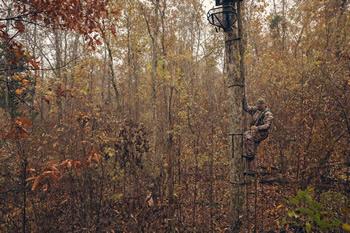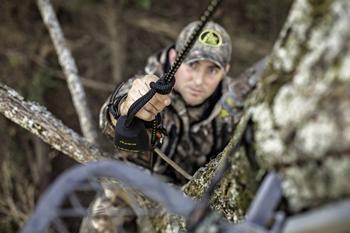 September 15, 2017 - David Clifton of Wells has shinnied up dozens of trees and spent hundreds of hours perched on lock-on, climbing and ladder deer stands over the years. All it took was a split second to show him how quickly things can go bad up there, especially when you thumb your nose in the face of safety.
September 15, 2017 - David Clifton of Wells has shinnied up dozens of trees and spent hundreds of hours perched on lock-on, climbing and ladder deer stands over the years. All it took was a split second to show him how quickly things can go bad up there, especially when you thumb your nose in the face of safety.
Shift to Fall of 1996.
Archery season was just around the corner and Clifton and a friend, John Allen, were in the woods hanging stands at their lease in western Nacogdoches County. In the process, Allen learned he was missing the ratchet strap used for securing the platform on his stand.
Rather than retrieving a replacement, Clifton elected to loan Allen his ratchet strap on the spot. That meant the platform on Clifton's stand would be left unsecured after he placed it.
Clifton's original idea was to bring a ratchet strap and secure the platform when he returned to the spot to hunt. Unfortunately, things didn't work out that way.
"When I went to hunt the stand for the first time I realized I had forgot the ratchet strap," Clifton said.
In hindsight, Clifton says the smartest thing he could have done would have been go to a different stand or abort the afternoon hunt altogether. Instead, he elected to take a huge risk that would ultimately change is life forever.
Clifton made up it up the white oak and onto the unsecured platform with no problem, nocked an arrow and laid his arrow quiver at his feet. He wasn't wearing a safety harness and didn't have a safety strap of any sort to support his weight in case the stand happened to give way.
Moments later, the hunter accidentally kicked the quiver off the platform and it fell to ground, 22 feet below. Arrows scattered everywhere.
"I knew there was a good buck in the area and I was afraid he would show up and spook if he happened see or smell that quiver on the ground," Clifton said. "I had to go get it."
Clifton said he hung his bow on a limb, exited the stand and retrieved the quiver.
"I climbed back up and laid the quiver across the platform," he recalled. "When I went to get back onto the platform is when it happened. I stepped on the edge of the platform and it kicked out to the opposite side. The last thing I remember is sort of jumping backwards and reaching out trying to grab the tree before I fell."
 Clifton, a 25-year-old firefighter at the time, said the fall knocked him unconscious for about five minutes. When he awoke he felt excruciating pain in both of his feet and back. Fire ants were eating him alive.
Clifton, a 25-year-old firefighter at the time, said the fall knocked him unconscious for about five minutes. When he awoke he felt excruciating pain in both of his feet and back. Fire ants were eating him alive.
Luckily, another hunter who was hunting about a 1/4 mile away heard his calls for help and was on the scene within minutes. Friends transported Clifton back to camp on an ATV, then loaded him in the back of a pick-up for the ride to the hospital.
X-rays showed both of his heels had been shattered and two bulging disks in his back. Once released from the hospital Clifton was bedfast for three months. It was six months before he was finally able to return to work.
"I remember getting out of bed and having to drag myself to the bathroom," Clifton said. "I spent a lot of time in a wheelchair and wearing walking boots just to get around. The doctors told me then that my feet and back would give me trouble the rest of my life. And they were right. I still feel it every single day."
Clifton offered no excuses for what happened to him 21 years ago this October. To hear him tell it, his pride caused him to make a very bad decision and take a chance that he never should have taken.
"I was a risk-taker back then," he said. "I could run up a tree like a cat squirrel and I would hang stands without tying off or taking any safety precautions. I knew full well what I was doing that day and it cost me dearly."
As a rule, most hunters today are way more conscious about playing it safe in the woods than they were 25 years ago. The push for exercising safety is particularly obvious among those who utilize tree stands.
That's largely because numerous organizations are spreading the word that there is no such thing as being too safe when hunting above the above the ground. In addition to heightened awareness, there are a wide variety of innovative safety products on the market today like safety harnesses, safety straps and lifelines that didn't exist years ago.
The Tree Stand Safety Awareness Foundation recently declared September as Tree Stand Safety Awareness Month. It's a timely designation because September is the month when thousands of hunters flock to the woods to hang stands, trim shooting lanes and do other odd jobs that are frequently performed 20-30 feet above ground.
In keeping with the safety message, TSSA has launched an educational campaign called the ABC's of Tree Stand Safety. The three step message goes as follows:
A.) Always remove and inspect your equipment.
B.) Buckle on your full body harness.
C.) Connect to the tree before your feet leave the ground.
By following those three simple steps "tree stand users can virtually eliminate their risk of falling to the ground as the majority of falls occur outside the stand," the campaign says. "TSSA encourages all hunters to take tree stand safety seriously, every time you hunt from, hang, or remove a tree stand."
Based in Roanoke, VA., the non-profit TSSA foundation was formed a couple of years ago by a group of outdoor industry leaders and hunting enthusiasts for the purpose of helping to reduce tree stand accidents through the promotion of tree stand safety and educating hunters about the best use practices.
TSSA president Glen Mayhew of Bedford, VA., has worked tirelessly for the cause and has helped assemble some eye-opening data about tree stand hunting accidents, how frequently they occur and the primary causes.
According to Mayhew, there were roughly 4,000 tree stand fall incidents nationwide in 2015 alone. While that number is relatively small in comparison to the number of hunters who utilize tree stands, it indicates that quite a few hunters aren't getting the important message about safety and/or making good use of products intended to prevent falls from happening.
"Depending on where you are in the country, there are more tree stand incidents than there are firearm incidents," Mayhew said. "From a deer hunting perspective, tree stand falls are the No. 1 cause of injury and death of our deer hunters on national level, not firearms."
Mayhew has spent a significant amount of time crunching numbers and factors related to tree stand incidents.
Not surprisingly, his data shows that nearly 86 percent of the accidents involved people who were not wearing a safety harness at the time. Another 14.5 percent had a harness with them that was either not connected, taken off, improperly used or properly used with only a minor injury.
The data shows more than 90 percent of the fatalities resulting from tree stand falls involved people who were not wearing a safety harness; 85.2 percent of those injuries were not wearing a safety harness. The average fall height for injuries was 16 feet; 19 feet for fatalities.
As earlier mentioned, there are a variety products on the market today that do a great job of enhancing tree stand safety without impeding on comfort.
One of best products a tree stand hunter can buy is a safety harness. The harness should be attached to a safety strap of some sort that is hard connected to the tree.
The best safety harnesses are made from heavy-duty nylon straps that provide support for the entire upper body, not just the waist. The harness should have two shoulder straps, a chest strap and two leg straps that fasten together as a single unit to keep you hanging upright in the event of a fall.
Another really good investment is some sort lifeline like the Hunter Safety Systems Lifeline. The heavy-duty rope device features two attachment points -- one for above the stand and one for the safety harness.
Use correctly, the LifeLine is advertised to eliminate the possibility of falling from a tree stand, because it keeps the hunter attached to the tree 100 percent of the time while ascending and descending from a stand platform.
You can never be too safe when it comes to hunting from a tree stand. All it takes is a split second to commit a fateful mistake that can change your life forever, or worse. David Clifton will testify to that.
"Safety awareness is a good thing," he said. "Those tree stands will sure get a fella'."
Matt Williams is a freelance writer based in Nacogdoches. He can be reached by e-mail, mattwillwrite4u@yahoo.com.









